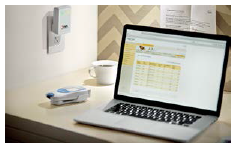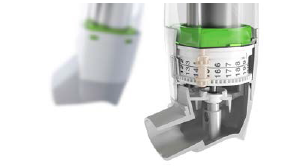Remote Patient Monitoring Device Market to Reach $1.5 Billion by 2024
Trending Now: From smart bras to inhalers, remote monitoring devices continue to gain traction.
Cardiovascular Diseases, Respiratory Disorders, and Diabetes Drive Growth in Global Remote Patient Monitoring Device Market
 According to a Persistence Market Research report, Remote Patient Monitoring Device Market: Global Industry Analysis and Forecast, 2016-2024, the global remote patient monitoring device market is expected to expand at a CAGR of 6.7% and is estimated to reach $1.5 billion by 2024, creating incremental opportunity of $657.1 million between 2016 and 2024.
According to a Persistence Market Research report, Remote Patient Monitoring Device Market: Global Industry Analysis and Forecast, 2016-2024, the global remote patient monitoring device market is expected to expand at a CAGR of 6.7% and is estimated to reach $1.5 billion by 2024, creating incremental opportunity of $657.1 million between 2016 and 2024.
Rising prevalence of cardiovascular diseases, respiratory disorders, and diabetes in the general population are major factors driving the growth of the global remote patient monitoring device market. Increasing healthcare expenditure and increasing availability of effective treatment solutions for chronic diseases is also projected to boost revenue growth of the global remote patient monitoring device market.
Other factors boosting market growth include an increasing awareness among people to self-monitor before disease advancement and government reimbursement issued on homecare settings facilities.
By 2024, the following segments are expected to have significant growth:
Cardiac monitor — $765.4 million, 6.9% CAGR
Hospital — $690.1 million, 6.6% CAGR
Respiratory monitor — $435 million, 6.5% CAGR
Cardiac arrhythmia — $307.7 million, 6.8% CAGR
Diabetes — $196.8 million, 5.6% CAGR
Homecare setting — $347.3 million, 6.2% CAGR
OMsignal Launches Smart Sports Bra
OMsignal has released its flagship product, OMbra, a sensor-embedded smart bra that captures the body’s deepest signals and streams the data to the user’s mobile device. It claims to be the first-ever sports bra to combine accurate heart and breathing rhythms to deliver actionable insights for runners of all levels. A customizable running app, OMrun, is included with the bra. OMrun scientifically determines each person’s intensity level for optimal progress and fat burning results, while helping reduce the risk of injury and fatigue.
Now available online at omsignal.com and in select retail stores across the United States and Canada, the company hopes to positively change consumers’ lives by providing more active apparel and everyday clothes into connected objects.
Roche Develops PT/INR Home Monitoring App
 Roche provides an updated app that allows patients to use their own devices for PT/INR testing in conjunction with the CoaguChek XS meter. The app is available exclusively to patients who test PT/INR with the support of CoaguChek Patient Services. Wireless-enabled patient self-testing with CoaguChek Patient Services enables HCPs to confidently monitor accurately reported patient PT/INR data remotely, while further reducing time and effort involved for patients and often caregivers.
Roche provides an updated app that allows patients to use their own devices for PT/INR testing in conjunction with the CoaguChek XS meter. The app is available exclusively to patients who test PT/INR with the support of CoaguChek Patient Services. Wireless-enabled patient self-testing with CoaguChek Patient Services enables HCPs to confidently monitor accurately reported patient PT/INR data remotely, while further reducing time and effort involved for patients and often caregivers.
Evidence suggests that patients who have a strong connection with their healthcare professional adhere better to their anticoagulant therapy plan. Patients enjoy increased convenience through PT/INR self-testing and physicians can be more confident they can optimize treatment decisions effectively as they have access to accurate patient data in near real time.
The CoaguChek XS mPOC kit engages patients in their care with a simple finger stick and 60-second test with just a drop of blood, giving patients the independence to continue their normal daily activities and quality of life while maintaining connections with their HCPs. The result is automatically communicated via Bluetooth to the CoaguChek mPOC app on the patient’s iPhone or iPad which transmits the result to CoaguChek Link – an online PT/INR data management solution. The managing clinician can then use CoaguChek Link to access – and act on – the results.
Biocorp Smart Sensor Converts Inhalers to Connected Devices
 Biocorp, a French company specializing in the development and manufacturing of medical devices and smart drug delivery systems, has launched Inspair, the smart sensor that converts inhalers into connected devices to help patients with asthma or COPD. Inspair is a smart sensor capable of converting any pressurized metered dose inhaler into a connected device: it is then able to record data related to the inhalations and to assure an optimal management of the treatment (mastering of the inhalation technique). Equipped with miniaturized sensors and electronic card, Inspair fits on most MDI mouthpieces on the market using specific adaptors. The system automatically records data related to daily inhalations, ensures the right preparation of the canister (shake before usage), assesses the coordination of actuation with inhalation (hand-mouth coordination) and also provides useful guidance throughout the inhalation steps.
Biocorp, a French company specializing in the development and manufacturing of medical devices and smart drug delivery systems, has launched Inspair, the smart sensor that converts inhalers into connected devices to help patients with asthma or COPD. Inspair is a smart sensor capable of converting any pressurized metered dose inhaler into a connected device: it is then able to record data related to the inhalations and to assure an optimal management of the treatment (mastering of the inhalation technique). Equipped with miniaturized sensors and electronic card, Inspair fits on most MDI mouthpieces on the market using specific adaptors. The system automatically records data related to daily inhalations, ensures the right preparation of the canister (shake before usage), assesses the coordination of actuation with inhalation (hand-mouth coordination) and also provides useful guidance throughout the inhalation steps.
University of South Dakota Studies Impact of At-Home Monitoring Devices
A recent partnership between the University of South Dakota Beacom School of Business, the South Dakota Governor’s Office of Economic Development, and Health Factors Inc., a private company that develops and implements connected health programs and solutions that drive better healthcare outcomes and lower costs, focused on what the impact would be of using at-home monitoring for patients with chronic obstructive pulmonary disease (COPD), pneumonia and congestive heart failure (CHF) who are at risk for complications that could lead to hospitalization.
Health Factors and the Beacom School of Business are analyzing claims data from the South Dakota Association of Healthcare Organizations to determine how actual hospital costs would have been affected if the point of hospital admittance were delayed through the use of at-home monitoring. The results will be used to determine the viability of a business based in South Dakota that would provide at-home monitoring services to reduce healthcare costs.
Through the claims analysis, Health Factors and Beacom identified several points in the care continuum where at-home monitoring could have a positive impact on patients with elevated risk. The COPD Foundation estimates that 40% of costs associated with COPD could be avoided by preventing complications and hospitalizations. Findings from the analysis will be used to identify and develop ways in which technology can connect patients to the care system throughout their healthcare journey, which supports early interventions that can reduce the need for hospitalization, improve quality of life for patients, and save money for all involved.
Study Identifies What Makes People Unfollow Brands on Social Media
Sprout Social recently conducted a survey of more than 1,000 people to get their thoughts on various aspects of branded social media content. And while the survey pool is relatively small, some compelling trends did emerge from the data, which are worth noting for those looking to maximize their company’s social media presence. Sprout found that a staggering 75% of respondents had made a purchase because of something they saw on social media.
First off, respondents indicated that the most annoying thing brands do on social is still over-promote.
“Information not relevant" was the second biggest issue. It’s important to be entertaining, to provide reasons why people would want to follow your brand, like promotions and incentives. But also, those messages need to be contextually relevant.
Using slang and jargon. Check out Twitter profiles such as Brands Saying Bae for more context on this front — in an effort to get in touch with the ever-elusive Millennial market, some are just trying too hard. Choose a communications style that makes sense for both your brand and your audience.
Not having any personality on their accounts. If your profile is just re-tweets or auto-generated messages or inspirational quotes with no context, how can you expect people to align with your brand and what your business is about? It’s important to define your brand mission and purpose before building your social media and content strategy.
Trying to be funny when they’re not. Similar to using slang and jargon, some brands just try too hard to be the cool kid in class in an effort to gain traction. Experimentation is a must; it’s always worth trying things out. But maybe, at some stage, you have to accept that it’s not working out.
Not replying to my message. It’s somewhat surprising that this didn’t feature more prominently, but then again, that likely relates to the consumptive nature of social, that we follow brands and pages we want to see content from, not necessarily those we want to send messages to. But the fact that this is important to a quarter of consumers is still significant, and this is only likely to increase as reliance on social platforms in our interactive process evolves.
More Than Half of Kaiser Permanente’s Patient Visits Are Virtual
At Salesforce’s Dreamforce conference in October, Kaiser Permanente reported that more interactions between Kaiser’s patients and healthcare providers were done virtually than through in-person visits. Last year, patients and doctors interacted more than 110 million times in total and 52% of them were done via smartphone, videoconferencing, kiosks, and other technology tools. Members are behaving more like consumers and medical information is a critical part of how they’re making life choices, says Kaiser CEO Bernard J. Tyson in a Fortune report. (PV)

















